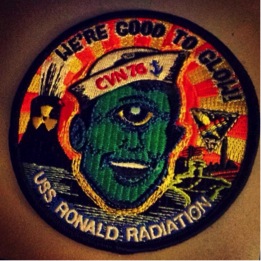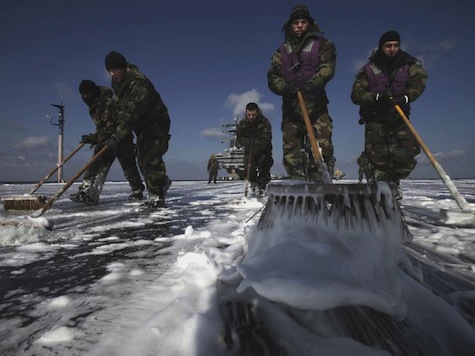It’s been more than three years since the Fukushima disaster, in which an earthquake and subsequent tsunami devastated the Fukushima region of Japan and significantly damaged its nuclear power plant.
Yet another earthquake hit Northern Japan on July 11, reminding the world of a tragedy that is commonly referred to as the worst nuclear disaster since Chernobyl. But in the years in between, the victims and first responders of the disaster have been left to cope with its destruction, both inside and out.
I was onboard the USS Ronald Reagan when we put a halt on a routine deployment after a deadly tsunami struck the coast of Japan in March 2011. The tsunami, triggered by the Tohoku earthquake, caused a major meltdown at the Fukushima Dai-ichi Nuclear Power Plants. The world watched while large amounts of radioactive material were dispersed into the atmosphere.
Mainstream media coverage, or lack thereof, barely began to highlight the hundreds of thousands of lives affected by the tragedy in Japan. In the immediate aftermath of the tsunami, mainstream media outlets fed off of hours of breathless coverage of the tsunami itself tearing through entire villages. CNN, in particular, benefited, experiencing a 400% increase in ratings in the days and weeks after the tsunami first struck. It offered a 24-hour, seven-day-a-week buffet of tragedy from the scene of the destruction, from puppies abandoned to radiation to Anderson Cooper realizing the limits of his temerity in real time, as news broke of a second explosion at the Fukushima Dai-Ichi nuclear plant.
Once the demand for news from Japan waned, however, little follow-up ever occurred in the media to those stories being told days after the tsunami struck, particularly those of American first responders.
The USS Ronald Reagan responded almost immediately to the tsunami disaster. The carrier, reports in 2013 noted, may have coasted through a radiation plume. Photos of bizarrely foamy snow aboard the ship began to circulate in some publications, most notably, the New York Post.
As our vessel inched its way toward the disaster site, ship’s leadership learned that we had navigated directly through a radiation cloud. The commanding officer warned us that our water and ventilation systems had been contaminated, posing a critical health risk to all of us onboard. We were advised to refrain from showering or drinking water until it was declared safe. Sailors worked tirelessly around the clock to facilitate victims on shore, while being left vulnerable to dangerous levels of radiation.
We spent the next several weeks rendering aid to civilians, a humanitarian mission later named “Operation Tomodachi.” While operating, most of us onboard the ship were tested for radiation exposure and many came back positive, resulting in full-body scrubdowns conducted by Navy hospital corpsmen.
Communication devices made of porous material were taken down and disposed of, due to contamination, and we were issued gas masks to carry on-hand in the event of a radiological outbreak.
Following our carrier’s departure, myself and other junior sailors were asked to don protective garments in an effort to decontaminate the ship. Decontamination made it possible for our command to enter a foreign port because the presence of radioactive material posed a risk to those on shore.
A class-action lawsuit, lead by San-Diego-based attorney Paul C. Garner, is currently in litigation as the list of plaintiffs continues to grow. The defendant, Tokyo Electric Power Company, is being charged with negligence for lulling the ship closer to the disaster site. They have yet to respond to the allegations.
“They certainly knew the severity of what was happening, because now you have radiological releases into the environment … and the tsunami just washed it all in, and washed it all out, and the Reagan was in the backwash,” Garner told the Navy Times last year.
Proper medical care for the victims of radiation exposure could rest solely on the outcome of the case, a dire situation for many who are already casualties of a broken VA healthcare system.
Conditions ranging from thyroid and hormone disorders to various forms of cancer have been reported by first responders. Many of us are enduring the unfortunate consequences both physically and psychologically as we wait for the court systems to decide our fate, hoping for care from the VA that appears to never arrive.
The Department of Veterans Affairs claims to recognize specific illnesses linked with radiation exposure, but when many of us inform the VA about our health concerns, we are reassured of our good health, despite the presence of mysterious and unexplained symptoms.
That the VA has achieved far less of what its goals as an agency should be made headlines prominently through much of 2014–so much so that VA Secretary Eric Shinseki resigned his position over accusations of inefficiency and potential fraud in veteran treatment records. A White House report released in June condemned what it described as a “corrosive culture” within the VA itself, something the veterans that works on Operation Tomodachi are acquainted with first-hand. But exposing the problem and solving it are two very different things, and solving that problem requires addressing the specific needs of every veteran whose time on duty has left them in need of adequate care.
A lack of coverage by the mainstream media has left victims without a voice in a time where the health of veterans has already been politicized and disregarded. We do not want to be forgotten.


COMMENTS
Please let us know if you're having issues with commenting.